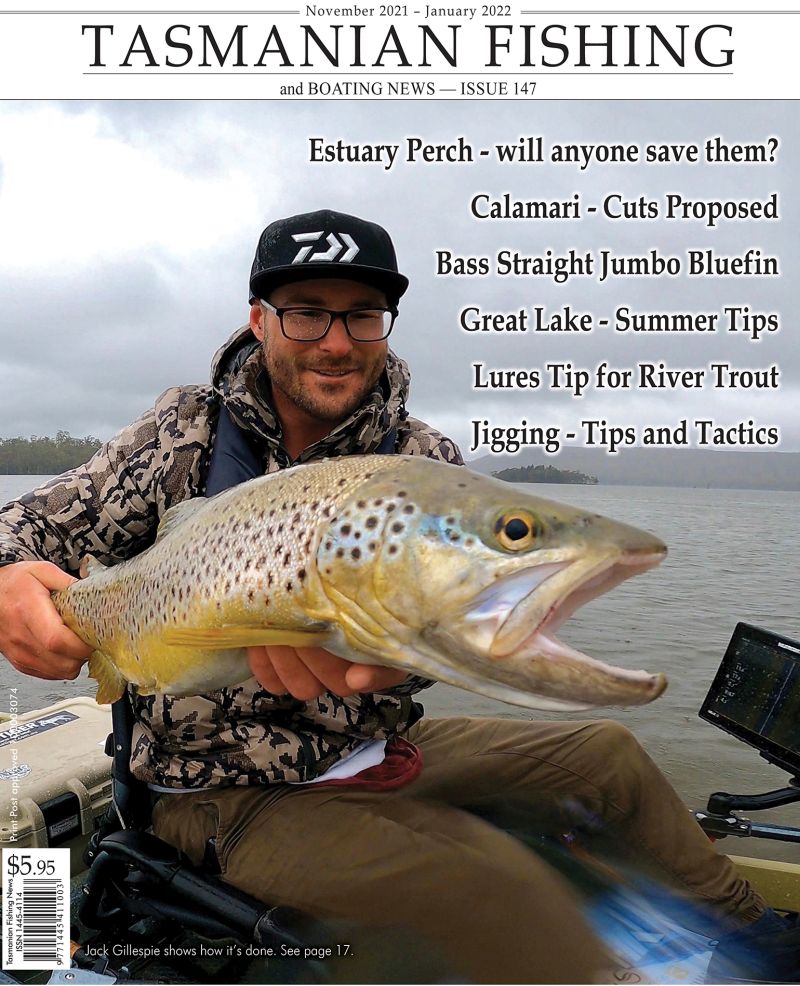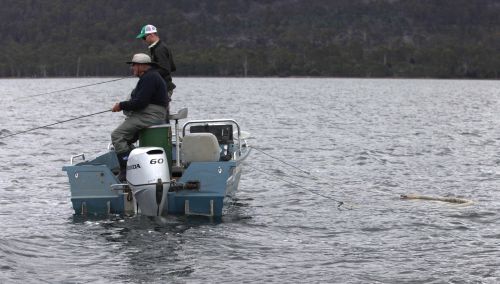Issue 147 November 2021 January 2022
Contents
Calamari — Why the recreational sector should fight cutbacks. 3
Estuary perch — Will someone save them? — Bryan van Wyk and Mike Stevens 5
Great Lake – Summer fun — Craig Rist 10
Chasing silver trevally — Nathan Huizing 15
Soft plastics for big trout — Jack Gillespie 17
Floating fly line techniques — Tom Jarman 21
Orange beads are best — Todd Lambert 24
Experience – and time on the water gets results — Lubin Pfeiffer 28
River lure fishing – the full kit — Adrian Webb 35
A Covid19 escape — Tim Johnson 38
Salty’s Bass Strait bluefin barrels — Kelly ‘Hooch’ Hunt 41
Calamari time — Richard Sherriff 46
Jigging is fun — Tim Whybrow 47
Recreational marine fishing news 49
Vale - Adrian Morrisby 51
I always think of it as a privilege to write an editorial. It is an opportunity to explain something, or to put forward an opinion.
This issue you will see - on opposite page in fact, we are trying to bring estuary perch (EP) back to the forefront. This is a native Tasmanian fish that is seriously at risk of disappearing. It needs some love from someone that can save it from extinction. If you think that sounds over the top, please read the story - and the supporting documents that are on www.tasfish.com
The Inland Fisheries Service has NEVER sought funding to manage, rehabilitate, survey or save this native fish. Perhaps so little is known about this fish in Tasmania no one cares. But if this were the mainland - Victoria being the best example EPs are highly regarded as sport fish. Victoria has a stocking program and it works extremely well. Tasmania is down to probably well under 2 000 wild fish and we do nothing.
EPs are easy to breed in a hatchery, and Tasmania has been breeding fish in hatcheries since 1864. Surely we can do something.
Estuary Perch are classified as a freshwater fish and it is a function of the Director to protect them. The Director, under the governing ACT (Inland Fisheries ACT 1995) has the power to do whatever is necessary to ensure estuary perch do not disappear.
The IFS has done an extraordinary effort to eradicate carp, so surely we have the skill sets for an easy job like this to bring this fish back. I truly hope they try.
Surely someone would like their legacy to be ‘I saved Tasmania’s Estuary Perch’.
Jumbo bluefin - that is enough to get any game fisher’s heart pumping. The discovery and progression of a game fishing zone in Bass Strait within a few minutes of Devonport is extraordinary.
Traditionally game fishing in Tasmania was an East Coast pursuit and NW coasters had a long haul to get to productive waters - anywhere between St Helens and Southport.
But it seems there have been a few factors that allowed a fishery to become productive closer to the NW coast.
One of the biggest factors must surely be the reduction of overfishing the southern bluefin fishery by the Japanese. They were caught red handed selling more fish than their total take quota. The fishery was heavily overfished. That was remedied some years ago and Tasmania has seen a huge resurgence. The next factor is better boats, more boats, better equipment and much smarter fishers.
Glen Saltmarsh got a handle on all this, got his butt into gear and worked out there were fish close to his home of Devonport. The bluefin story in this issue tells that story.
Then there is calamari.
Maybe a bit like the Japanese overfishing bluefin, we have the commercial sector also overfishing calamari and now the fisheries department thinks it is a good idea to cut back the recreational sector’s take.
I do not like targeting or pointing out the commercial sector is over-fishing - and it is not their fault - fishery rules allow them to do so. The fisheries department should have addressed this issue years back when they knew. But they didn’t.
A paper ‘Tasmanian Calamari Fishery - Managing Stocks for Sustainability - Discussion Paper - October 2021’ was released. It suggests recreational fishers go to the lowest bag limit in Australia to save calamari. All that needs to happen is constraint on the commercial sector and a closure to protect spawning biomass - as recognised in the research available. Close the fishery to all from August to October and the fishery will recover.
It is good to see TARFish recognising how important this issue is to keep our individual bag limits as is, not just for calamar, but all species. I am prepared to fully support rec. fishers and TARFish on this one. Bring it on.
I hope the Minister, Guy Barnett, really listens to recreational fishers, he fishes himself, and it seems the department only listens to the commercial sector.
Lastly, it amazes me, after 25 years of publishing TFBN we still have such fantastic stories and contributions. Thank you all.
Mike Stevens - Editor
Mike Stevens
Tasmanian Fishing and Boating News
Stevens Publishing PO Box 7504, Launceston, Tas 7250
Phone 0418 129949



